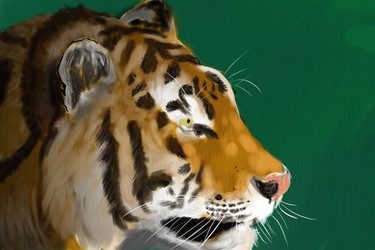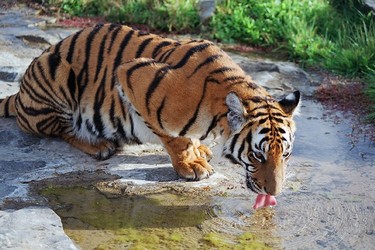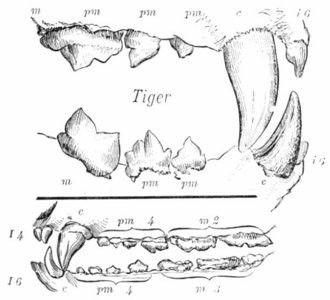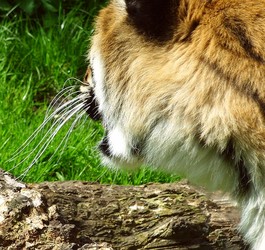

Panthera tigris. © 2008 Andrew Park. Used a photo taken by $hexentanz of deviantART as a reference.
Classification

Tigers might be massive, but they are still cats. © 2005 World66.

Tiger's Teeth.

Vibrissae of a tiger. © 2008 Black Stripe
- Kingdom - Animalia
- Phylum - Chordata
- Class - Mammalia
- Order - Carnivora
- Family - Felidae
- Genus - Panthera
- Species - Panthera tigris
As tigers have warm blood and hair (fur), and since they also give live birth, they are categorized under the Class Mammalia. They are meat eaters, therefore the classification under the order of Carnivora. Felidae, the family of cats. Lastly, Genus of Panthera is for large, yellow cats.
Introduction
Tigers are the largest of all species of the Family Felidae. The different subspecies of tigers grow up to 1.4 to 3 m and weights of 100 to 300 kg. Their distinctive feature compared to other species of the genus Panthera is their orange body with long black stripes vertically running down their body. The coat also has a few white markings on the face and on the belly. P. tigris inhabit Eastern Asia. The largest subspecies of P. tigris is P. tigris altaica, the Siberian tiger. They mostly inhabit the farthest Eastern corner of the Asian continent in eastern China, eastern Russia and in the Korean Peninsula.
Habitat, Diet and Adaptation to the Environment
Although the range of distribution has dwindled, tigers still can be found at various locations. Tigers inhabit areas from tropical rainforests to frigid Siberia wherever there is vegetative cover, access to water and ungulate prey such as deer and wild boars.
Tigers prey on wild boars, large deer and wild cattle. Sometimes, they will even feed on livestock. Tigers eat about 13 to 16 kg of meat a day. Tigers developed the typical predatory sequence of stalking and striking at the last minute. They have powerful legs which allow a tiger to run at the speed of 60 km/h and strike with their deadly jaws. However, typically, tigers have only one successful kill per 10 to 20 hunts.
Reproduction
Male and female tigers meet only briefly to mate. During that period, they mate frequently. The gestation period is between 100 to 112 days, and between 2 to 4 cubs are born. The mother protects her offspring until they are able to become independent around the age of 18 months. However, these tiger cubs only have a 50% chance of surviving until they become independent from their mother, and then, only 40% of these survivors live to establish their own territories and mate. When a young male grows up, he wanders far away from his birthplace in search for new territories, but young females establish territories adjacent to their mothers.
Endangered
The tiger is an endangered species. Commercial poaching and loss of habitat are the major reasons for the declining of the tigers' population. Tigers were also killed for livestock predation, and in the 20th century, they were hunted in large numbers in China and Russia as they were considered pests. Tigers were also hunted for their skin, as well as for oriental medication usage. As the human population has grown it expanded into the tigers' habitats reducing the number of tigers an area can support.
Importance to the Ecosystem
As P. tigris is a top trophic level carnivore, it maintains the balance between prey herbivores and the vegetation which they feed upon.
Tiger Crossword

Can you solve this crossword puzzle about tigers?
Information on the Internet
- WWF- Tigers A World Wide Fund for Nature Website with many useful facts on Tigers.
- IUCN Red List of Threatened Species- Panthera tigris An International Union for Conservation of Nature website.
- Tiger, Panthera tigris A Zoogoer website.



 Go to quick links
Go to quick search
Go to navigation for this section of the ToL site
Go to detailed links for the ToL site
Go to quick links
Go to quick search
Go to navigation for this section of the ToL site
Go to detailed links for the ToL site